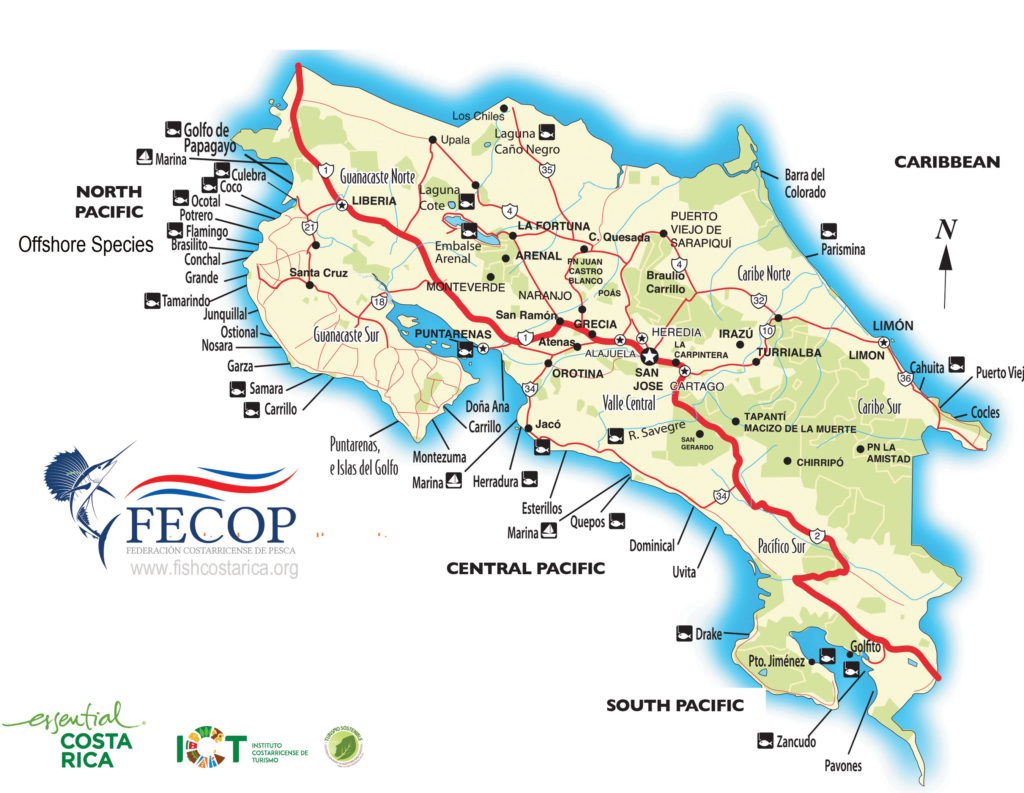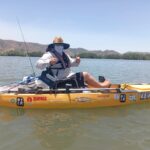Costa Rica Map and General Tourism Information
Planning a Costa Rica fishing vacation? Here is a birds-eye view of all the best fishing destinations from Coast to Coast!
Costa Rica Fishing Map – See the fish icons below for Costa Rica fishing areas/towns. Read more general tourist information about Costa Rica below the map. Visit this page for more information about planning a Costa Rica fishing trip

Location
Costa Rica is located in Central America, south of Nicaragua and north of Panama. The western side of the country is bordered by the Pacific Ocean and the eastern side by the Caribbean Sea
Capital City San José Population (est.) 4.8 million
Language The native language is Spanish and English is spoken throughout various tourist areas of the country
Climate Temperatures range from 70 to 81 degrees all year round. While many tropical countries have changing weather patterns that affect the entire nation with different seasons, Costa Rica enjoys 12 different tropical micro climates that remain constant throughout the year. The most common micro climate in Costa Rica is the Tropical Moist Forest, which is filled with evergreen trees and bountiful vines, but the Tropical Sub alpine Rain Páramo is a micro climate with temperatures ranging around 41º and 57º Fahrenheit, with occasional snowfall and hail. The water temperature on both coasts is at a reliable 28-29 degrees Celsius (84°F)
Currency The national currency is the Costa Rican Colon (CRC), though U.S. dollars and credit cards are widely accepted.
The exchange rate as of 2019 is approximately 590 CRC to $1, but can vary daily
International Airports
San Jose: Juan Santamaría International Airport (SJO – Costa Rica’s Main Airport )and Tobías Bolaños International Airport
Liberia: (New International Airport in Costa Rica’s Northern Zone ) Daniel Oduber International Airport Airlines American Airlines, Air Canada, Alaska Airlines.
Copa, Delta AirLines, jetBlue, Spirit Airlines, Avianca Airlines, United, U.S.Airwaysand Westjet
Entry Requirements U.S. and Canadian citizens need a valid passport – valid from 6 months AFTER your planned EXIT date. If you are not fully vaccinated travel insurance is required. Don’t forget to fill out your health pass and get your QR code 24 hours before arriving in the country.
Tourism Information For updated COVID 19 guidelines and more information, please visit www.visitcostarica.com
ABOUT COSTA RICA
Costa Rica is located in Central America, bordered on the east by the Caribbean Sea and the west by the Pacific Ocean. Opportunities for sport fishing , adventure, relaxation, romance and exploration are unlimited, making it one of the most visited international destinations in the Western Hemisphere.
With an abundance of unique wildlife, an amazing variety of saltwater and freshwater fish, landscapes and climates the country proudly shelters approximately five percent of the existing biodiversity in the world, with protected areas comprising 26 percent of its land mass. The phrase “Pura Vida” can be heard echoing throughout Costa Rica from coast to coast. Used as a greeting or expression of happiness, the phrase literally translates to “pure life,” however its truer meaning is “full of life,” which accurately describes the adventure and wonder that await visitors. Beach lovers, surfers, divers and anglers quickly feel right at home along the coasts while couples and those in search of a relaxing retreat are captivated and pampered by the country’s natural beauty and diverse spas and retreats. Thrill seekers have met their match further inland as they explore Costa Rica’s volcanoes, rain forests, cloud forests, and rivers primed for white-water adventures. In order to protect and preserve such a wealth of natural resources Costa Rica has become a leader in sustainable tourism and established the Certification for Sustainable Tourism (CST) which has a fundamental purpose of benefitting the environment and supporting the community. Business is bustling in Costa Rica, as the country is home to headquarter offices for a myriad of multinational corporations in the global marketplace. Business and group travelers will find a plethora of hotel and meeting space options, as the country hosts a sophisticated infrastructure of hotels and international brands.
GEOGRAPHY
Costa Rica’s bio diverse terrain is a key element that attracts visitors from around the world. Bordered by the Pacific Ocean and the Caribbean Sea, with a land portion that occupies only 20 thousand square miles, it is no surprise that Costa Rica’s name translates to “rich coast.” The Central American country shares borders with Nicaragua to the north and Panama to the south.The nation is comprised of seven provinces: San José, Alajuela, Cartago, Heredia, Guanacaste, Puntarenas and Limón.
From mountain ranges and rain forests to active volcanoes and cloud forests to breathtaking beaches, Costa Rica’s diversity of landscapes, climates and natural wonders provides visitors with unlimited experiences.
CENTRAL VALLEY
Many Costa Rica fishing trips start with a one day stayover in San Jose, Costa Rica. Home to the destination’s capital, San José, many of Costa Rica’s most popular museums can be found in this urban setting including the Gold Museum, Jade Museum, National Museum and Children’s Museum, in addition to the architectural jewel of Costa Rica, the National Theater. Out in the surrounding highlands, visitors can discover two active volcanoes, Poás and Irazú, as well as the Braulio Carrillo National Park. The rural towns of Turrialba and Valle de los Santos are also in the Central Valley, offering a picturesque glimpse of old Costa Rican traditional homes, large coffee plantations, sugar mills and dairies.
MID PACIFIC
Great fishing, beautiful beaches, wildlife sanctuaries, lagoons, rivers and waterfalls make the Mid Pacific region an ideal destination for visitors in search of variety. The region stretches from the city of Puntarenas, heradurra to Dominical de Osa and is made up of some of Costa Rica’s most visited areas including Quepos, Jacó, Bahía Ballenaand Manuel Antonio. The region’s climate creates a unique landscape that transitions from tropical wet forest to tropical forest to tropical dry forest, providing the opportunity to observe a wide range of plants and animals and of course exotic Costa Rica fishing species. In addition to wildlife, the Mid Pacific region is home to a number of luscious beaches and great inshore and offshore fishing spots, some of which are less than two hours from San José.
THE CARIBBEAN COAST
The Caribbean side is world-famous for tarpon and snook. Tarpon school up outside the mouth of the river in pods that cover several acres. When it is hot, it is red hot and you will pull on big fish all day.
The diverse coastline of the Northern Caribbean region attracts anglers, naturists and water enthusiasts in search of unique experiences. The North Caribbean region runs from the San Juan River (Tarpon and Snook fishing )to Limón City, located just south of Nicaragua, and as far West as the Eastern Sarapiquí canton. Visitors to the region can head out bass fishing in rivers, lakes and streams, embark on a fascinating excursion through the area’s interconnected canals or have the opportunity to witness green turtles nesting at Tortuguero National Park.
Limón City, the largest city on the country’s Caribbean coast, welcomes thousands of cruise passengers and serves as a popular tourism and distribution center. The Southern Caribbean boasts some of Costa Rica’s best beaches and picturesque parks, which are complemented by the area’s inviting culture. The region, which extends from Limón City to the Panamaborder, features a unique blend of natural wonders and Afro-Caribbean traditions.
A wide range of activities allow travelers to mix adventure with natural history, present day culture, gastronomy and music. The region is also home to Cahuita National Park and Gandoca Manzanillo Reserve.
THE PACIFIC COAST
The Pacific side of Costa Rica boasts two fishing seasons, with the central and southern regions most productive November through April. In the north, the good bite is from May through December. The last few years have seen record numbers of sailfish on the Pacific side of Costa Rica. El Niño slowed the bite last year, but during the two previous years, records were broken for the number of releases in the Los Sueños and Marina Pez Vela tournaments. Last year in the Offshore World Tournament at Marina Pez Vela, the sailfish were noticeably absent, while marlin released records were crushed. Read the FECOP Guide to Costa Rica fishing – Where to go, What You’ll Find for more information
GUANACASTE – Northern Pacific
The combination of breathtaking white-sand beaches, sweeping mountain views and an ideal tropical climate has made Guanacaste one of Costa Rica’s most popular regions. Located in the northwestern corner of Costa Rica, the region presents a diverse geography and boasts many of Costa Rica’s most popular beaches, including Playa del Coco, Playa Flamingo, Playa Conchal, Tamarindo and the Papagayo Peninsula. By day visitors can challenge themselves with a surf lesson, cool off under a waterfall at Rincónde la ViejaNational Park, discover the craters of an active volcano with the same name and more before enjoying the active nightlife in Tamarindo. High up in the mountains of Guanacaste, visitors have the opportunity to experience ecological tourism in a natural and picturesque environment
The beach’s pristine waters are ideal for a variety of water sports and some of the world’s best deep sea fishing.
Tamarindo, one of the most developed and popular beaches on the Pacific Coast, offers some of the best surfing and windsurfing in the world with a laid-back vibe to match. Long stretches of sand are perfect for walks, horseback riding and sunbathing. Offering a wide variety of water sports, excursions and restaurants, Tamarindo is a bustling beach town with plenty for visitors to experience.
On the Nicoya Peninsula, picture-perfect beaches offer snorkeling, diving and windsurfing. Samara is one of the region’s most pleasant beaches and although it is peacefully secluded, there is no shortage of restaurants, shops, excursions or hotels. Protected by a coral reef, allowing the waters near the coast to be calm and safe, Samara is particularly known for its pleasant swimming conditions. For a more quiet experience, visitors can venture just north or south to the undeveloped sands of Barrigona, Buena Vista or Playa Carrillo.
THE CENTRAL AND SOUTH PACIFIC
Continuing south toward the mid-pacific, Jacó Beach is one of the world’s most renowned surfing destinations, known for its consistent waves. A short drive from San José, Jacóis a popular weekend getaway for locals and party goers ready to paint the town .Home to the continent’s largest Pacific coastal rain forests and some of the world’s most endangered species,Puntarenas’ beaches are lush and tropical as a result of the frequent rainfall.
Bahía Ballenais located south of Dominical and at low tide displaysa coastline that resembles a whale’s tail.An interesting fact about this bay is that whales from the north and south find the water’sreliable temperature of 82 degrees Fahrenheit asideal for birthing, allowing for two whale watching seasons to take place.Children love to spot the different humpback, pilot and false killer whales. While on these tours, visitors can also sight bottlenose and spotted dolphin sall year round.The neighboring beaches of Manuel Antonio are some of the country’s most immaculate. Surrounded by dense forest vegetation, the beaches of Espadilla, Blanca and Puerto Escondido are inside Manuel Antonio National Park, offering visitors often unexpected views of exotic wildlife.Nearby Dominical is known for its authenticity and world-class surfing. Frequented by backpackers seeking an experience that differs from usual tourist destinations, the unspoiled nature of Dominical offers thrilling water sports and awe-inspiring sights, including the Dominicalito and Naucaya Waterfalls. Surfing is particularly noteworthy on Pavones, a simple mile-long beach where surfers can ride the longest left-breaking waves in the world. Home to some of the
best conditions on the entire Pacific coast of North and South America, the rocky beach of Pavones is a surfer’s paradise.
Adrenaline
Outdoor enthusiasts can rejoice in the wealth of water-based activities to choose from in Costa Rica. Sport fishing, surfing, diving and rafting are several popular favorites, and the combination of a wide range of difficulty levels and destinations where visitors can partake create the perfect activity for everyone in a group.
COSTA RICA SPORT FISHING
Check out the following Links for Great Costa Rica Fishing Information:
Costa Rica Fishing – Where to go, What You’ll Find
Chasing Sailfish and Marlin in Costa Rica’s Central Pacific
Why Costa Rica is the Perfcet Destination to Take the Kids Fishing
Catching Cubera Snapper in Costa Rica’s South Pacific
Costa Rica Fishing – How and Whtere to Catch Trophy Roosterfish
Sailfish For Dummies – Catching Sailfish in Costa Rica
Fresh Water Fishing in Costa Rica for Rainbows
The Northern Pacific coast, Central Pacific region, Southern Pacific region, and Caribbean coast all make for great fishing spots. Travelers can enjoy offshore fishing in the area of Quepos on the central Pacific coast, boasting large billfish such as sailfish and marlin and sport fishing in the small harbor town of Golfito on the southern coast or Puerto Jimenez – The largest town in the Osa Peninsula and the gateway to Corcovado National Park.
On the Caribbean coast, more unpredictable conditions can cause variation in the day’s tarpon and snook catches; however, fishermen can generally expect tarpon during the winter and spring and snook during the fall.
For those who enjoy inland fishing, Lake Arenal, Costa Rica’s largest lake located at the foot of the active Arenal Volcano, boasts rainbow bass. Fishing seasons vary by location and type of fish, and a valid Costa Rican fishing license is required for any freshwater fishing done in the country.
Sport Fishing Generates Nearly 500 Million Dollars Annually in Costa Rica



















